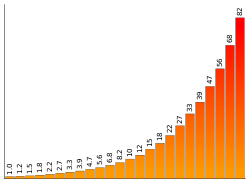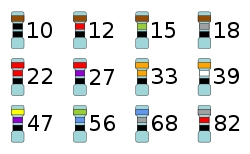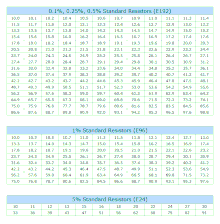E series of preferred numbers
The E series is a system of preferred numbers (also called preferred values) derived for use in electronic components. It consists of the E3, E6, E12, E24, E48, E96 and E192 series,[1] where the number after the 'E' designates the quantity of value "steps" in each series. Although it is theoretically possible to produce components of any value, in practice the need for inventory simplification has led the industry to settle on the E series for resistors, capacitors, inductors, and zener diodes. Other types of electrical components are either specified by the Renard series (for example fuses) or are defined in relevant product standards (for example IEC 60228 for wires).

History
In the early 20th century, capacitor (previously called condenser)[2][3] and resistor[4][5][6][7] value increments were different than today.[8]
American and British military production during World War II was a major influence for establishing common standards across many industries, especially in electronics, where it was essential to produce large quantities of standardized electronic parts very quickly. Later, the post–World War II baby boom and the invention of the transistor kicked off demand for consumer electronics goods during the 1950s. As transistor radio production migrated towards Japan during the 1950s, it was critical for the electronic industry to have international standards.
Over time, components evolved towards common values, then based on some of these existing conventions,[6][7] as worked on by the Radio Television Manufacturers Association (RTMA),[9] the International Electrotechnical Commission (IEC) began work on an international standard in 1948.[10] The first version of this IEC Publication 63 (IEC 63) was released in 1952.[11] Later, IEC 63 was revised, amended, and renamed into the current version known as IEC 60063:2015.[12]
IEC 60063 release history:
- IEC 63:1952 (aka IEC 60063:1952), first edition, published 1952-01-01.[11]
- IEC 63:1963 (aka IEC 60063:1963), second edition, published 1963-01-01.[10]
- IEC 63:1967/AMD1:1967 (aka IEC 60063:1967/AMD1:1967), first amendment of second edition, published 1967.[10]
- IEC 63:1977/AMD2:1977 (aka IEC 60063:1977/AMD2:1977), second amendment of second edition, published 1977.[10]
- IEC 60063:2015, third edition, published 2015-03-27.[12]
Overview
The E series of preferred numbers were chosen such that when a component is manufactured it will end up in a range of roughly equally spaced values on a logarithmic scale. Each E series subdivides each decade magnitude into steps of 3, 6, 12, 24, 48, 96, 192 values.[nb 1] Subdivisions of E3 to E192 ensure the maximum error will be divided in the order of 40%, 20%, 10%, 5%, 2%, 1%, 0.5%. Also, the E192 series is used for 0.25% and 0.1% tolerance resistors too.
Historically, the E series is split into two major groupings:
- E3, E6, E12, E24 --- E3, E6, E12 are subsets of E24. Values in this group are rounded to 1 trailing digit.
- E48, E96, E192 --- E48 and E96 are subsets of E192. Values in this group are rounded to 2 trailing digits.
Since the electronic component industry established component values before standards discussions in the late-1940s, they decided that it wasn't practical to change the former established values. These older values were used to create the E6, E12, E24 series standard that was accepted in Paris in 1950 then published as IEC 63 in 1952. Eight of the E24 values do not match the following formula.
The formula for each value is determined by the n-th root:
- where is the rounded value, is an integer of the E series group size, and is an integer of {0, 1, 2, ..., m-1}.
For E3 to E24, the values are rounded to 1 trailing digit. For unknown historical reasons, eight older industry values (shown in bold) are different from the calculated values.
Official E24 1.0 1.1 1.2 1.3 1.5 1.6 1.8 2.0 2.2 2.4 2.7 3.0 3.3 3.6 3.9 4.3 4.7 5.1 5.6 6.2 6.8 7.5 8.2 9.1 Calculated E24 1.0 1.1 1.2 1.3 1.5 1.6 1.8 2.0 2.2 2.4 2.6 2.9 3.2 3.5 3.8 4.2 4.6 5.1 5.6 6.2 6.8 7.5 8.3 9.1
- The eight official E24 values shown in bold do not exist in the E48, E92, E192 series.
For E48 to E192, the values are rounded to 2 trailing digits.
- To calculate the E48 series: is 48, then is incremented from 0 to 47 through the formula.
- To calculate the E96 series: is 96, then is incremented from 0 to 95 through the formula.
- To calculate the E192 series: is 192, then is incremented from 0 to 191 through the formula, with one exception where 9.20 is official instead of calculated 9.19.
Example
The E3 series is defined as the values 1.0, 2.2, and 4.7. If a manufacturer sold resistors with E3 series values in a range of 1 ohm to 10 megaohms, the available resistance values would be:
- 1 Ω, 2.2 Ω, 4.7 Ω,
- 10 Ω, 22 Ω, 47 Ω,
- 100 Ω, 220 Ω, 470 Ω,
- 1 kΩ, 2.2 kΩ, 4.7 kΩ,
- 10 kΩ, 22 kΩ, 47 kΩ,
- 100 kΩ, 220 kΩ, 470 kΩ,
- 1 MΩ, 2.2 MΩ, 4.7 MΩ,
- 10 MΩ.
Obsolete
The E3 series is rarely used,[nb 1] except for some components with high variations like electrolytic capacitors, where the given tolerance is often unbalanced between negative and positive such as −30/+50% or −20/+80%, or for components with uncritical values such as pull-up resistors. The calculated tolerance for this series gives (3√10 − 1) ÷ (3√10 + 1) = 36.60%. While the standard only specifies a tolerance greater than 20%, other sources indicate 40% or 50%. Currently, most electrolytic capacitors are manufactured with values in the E6 or E12 series, thus E3 series is mostly obsolete.
E24 vs. E48, E96, E192
Since some values in the E24 series do not exist in the E48, E96 and E192 series, resistor manufacturers have added the missing E24 values to some of their 1%, 0.5%, 0.25%, 0.1% tolerance families. This allows easier purchasing migration between different tolerance parts. This type of combination is noted on resistor datasheets and webpages as "E96 + E24" and "E192 + E24".[13][14][15]
Comparison of E24 vs. E48 values:
- matching – 1.00, 1.10, 7.50
- missing – 1.20, 1.30, 1.50, 1.60, 1.80, 2.00, 2.20, 2.40, 2.70, 3.00, 3.30, 3.60, 3.90, 4.30, 4.70, 5.10, 5.60, 6.20, 6.80, 8.20, 9.10
Comparison of E24 vs. E96 values:
- matching – 1.00, 1.10, 1.30, 1.50, 2.00, 7.50
- missing – 1.20, 1.60, 1.80, 2.20, 2.40, 2.70, 3.00, 3.30, 3.60, 3.90, 4.30, 4.70, 5.10, 5.60, 6.20, 6.80, 8.20, 9.10.
Comparison of E24 vs. E192 values:
- matching – 1.00, 1.10, 1.20, 1.30, 1.50, 1.60, 1.80, 2.00, 2.40, 4.70, 7.50
- missing – 2.20, 2.70, 3.00, 3.30, 3.60, 3.90, 4.30, 5.10, 5.60, 6.20, 6.80, 8.20, 9.10
Lists

List of values for each E series:[nb 1]
- E3 values (40% tolerance)
- 1.0, 2.2, 4.7
- E6 values (20% tolerance)
- 1.0, 1.5, 2.2, 3.3, 4.7, 6.8
- E12 values (10% tolerance)
- 1.0, 1.2, 1.5, 1.8, 2.2, 2.7, 3.3, 3.9, 4.7, 5.6, 6.8, 8.2
- E24 values (5% tolerance)
- 1.0, 1.1, 1.2, 1.3, 1.5, 1.6, 1.8, 2.0, 2.2, 2.4, 2.7, 3.0, 3.3, 3.6, 3.9, 4.3, 4.7, 5.1, 5.6, 6.2, 6.8, 7.5, 8.2, 9.1
- E48 values (2% tolerance)
- 1.00, 1.05, 1.10, 1.15, 1.21, 1.27, 1.33, 1.40, 1.47, 1.54, 1.62, 1.69, 1.78, 1.87, 1.96, 2.05, 2.15, 2.26, 2.37, 2.49, 2.61, 2.74, 2.87, 3.01, 3.16, 3.32, 3.48, 3.65, 3.83, 4.02, 4.22, 4.42, 4.64, 4.87, 5.11, 5.36, 5.62, 5.90, 6.19, 6.49, 6.81, 7.15, 7.50, 7.87, 8.25, 8.66, 9.09, 9.53
- E96 values (1% tolerance)
- 1.00, 1.02, 1.05, 1.07, 1.10, 1.13, 1.15, 1.18, 1.21, 1.24, 1.27, 1.30, 1.33, 1.37, 1.40, 1.43, 1.47, 1.50, 1.54, 1.58, 1.62, 1.65, 1.69, 1.74, 1.78, 1.82, 1.87, 1.91, 1.96, 2.00, 2.05, 2.10, 2.15, 2.21, 2.26, 2.32, 2.37, 2.43, 2.49, 2.55, 2.61, 2.67, 2.74, 2.80, 2.87, 2.94, 3.01, 3.09, 3.16, 3.24, 3.32, 3.40, 3.48, 3.57, 3.65, 3.74, 3.83, 3.92, 4.02, 4.12, 4.22, 4.32, 4.42, 4.53, 4.64, 4.75, 4.87, 4.99, 5.11, 5.23, 5.36, 5.49, 5.62, 5.76, 5.90, 6.04, 6.19, 6.34, 6.49, 6.65, 6.81, 6.98, 7.15, 7.32, 7.50, 7.68, 7.87, 8.06, 8.25, 8.45, 8.66, 8.87, 9.09, 9.31, 9.53, 9.76
- E192 values (0.5% and lower tolerance)
- 1.00, 1.01, 1.02, 1.04, 1.05, 1.06, 1.07, 1.09, 1.10, 1.11, 1.13, 1.14, 1.15, 1.17, 1.18, 1.20, 1.21, 1.23, 1.24, 1.26, 1.27, 1.29, 1.30, 1.32, 1.33, 1.35, 1.37, 1.38, 1.40, 1.42, 1.43, 1.45, 1.47, 1.49, 1.50, 1.52, 1.54, 1.56, 1.58, 1.60, 1.62, 1.64, 1.65, 1.67, 1.69, 1.72, 1.74, 1.76, 1.78, 1.80, 1.82, 1.84, 1.87, 1.89, 1.91, 1.93, 1.96, 1.98, 2.00, 2.03, 2.05, 2.08, 2.10, 2.13, 2.15, 2.18, 2.21, 2.23, 2.26, 2.29, 2.32, 2.34, 2.37, 2.40, 2.43, 2.46, 2.49, 2.52, 2.55, 2.58, 2.61, 2.64, 2.67, 2.71, 2.74, 2.77, 2.80, 2.84, 2.87, 2.91, 2.94, 2.98, 3.01, 3.05, 3.09, 3.12, 3.16, 3.20, 3.24, 3.28, 3.32, 3.36, 3.40, 3.44, 3.48, 3.52, 3.57, 3.61, 3.65, 3.70, 3.74, 3.79, 3.83, 3.88, 3.92, 3.97, 4.02, 4.07, 4.12, 4.17, 4.22, 4.27, 4.32, 4.37, 4.42, 4.48, 4.53, 4.59, 4.64, 4.70, 4.75, 4.81, 4.87, 4.93, 4.99, 5.05, 5.11, 5.17, 5.23, 5.30, 5.36, 5.42, 5.49, 5.56, 5.62, 5.69, 5.76, 5.83, 5.90, 5.97, 6.04, 6.12, 6.19, 6.26, 6.34, 6.42, 6.49, 6.57, 6.65, 6.73, 6.81, 6.90, 6.98, 7.06, 7.15, 7.23, 7.32, 7.41, 7.50, 7.59, 7.68, 7.77, 7.87, 7.96, 8.06, 8.16, 8.25, 8.35, 8.45, 8.56, 8.66, 8.76, 8.87, 8.98, 9.09, 9.20, 9.31, 9.42, 9.53, 9.65, 9.76, 9.88
Table
|
|
|
See also
| Wikimedia Commons has media related to E12 values. |
- Electronic color code – color-code used to indicate the values of axial electronic components, such as resistors, capacitors, inductors, diodes (also see IEC 60062).
- Preferred numbers
- Renard series - used for current rating of electric fuses
- 1-2-5 series
- Geometric progression
Notes
- Some part vendors also list an "E1 series" (with only the value "1"). However, this does not appear to have been standardized in any version of the IEC standard.
References
- Chip Resistors - Product catalog (PDF). Passive System Alliance (PSA) / Walsin Technology Corp. August 2018. p. 2. Archived (PDF) from the original on 2020-01-04. Retrieved 2019-03-23.
[…] E1 series resistance: 1 Ω, 10 Ω, 100 Ω, 1000 Ω, 10000 Ω, 100000 Ω […]
- Catalog – Capacitors (Condensers). Allied Radio. 1930. p. 139. Archived from the original on 2017-07-11. Retrieved 2017-07-11.
- "Catalog – Capacitors (Condensers)". RadioShack. 1940. p. 54. Archived from the original on 2017-07-11. Retrieved 2017-07-11.
- Catalog – Resistors. Allied Radio. 1930. p. 141. Archived from the original on 2017-07-11. Retrieved 2017-07-11.
- "Catalog – Resistors". RadioShack. 1940. p. 60. Archived from the original on 2017-07-11. Retrieved 2017-07-11.
- Buttner, Harold H.; Kohlhaas, H. T., eds. (1943). Reference Data for Radio Engineers (1 ed.). Federal Telephone and Radio Corporation (FTR). pp. 37–38. Retrieved 2020-01-03. (NB. This 1943 publication already shows a list of new "preferred values of resistance" following what was adopted by the IEC for standardization since 1948 and later standardized in IEC 63:1952. For comparison, it also lists "old standard resistance values" as follows: 50, 75, 100, 150, 200, 250, 300, 350, 400, 450, 500, 600, 750, 1000, 1200, 1500, 2000, 2500, 3000, 3500, 4000, 5000, 7500, 10000, 12000, 15000, 20000, 25000, 30000, 40000, 50000, 60000, 75000, 100000, 120000, 150000, 200000, 250000, 300000, 400000, 500000, 600000, 750000, 1 Meg, 1.5 Meg, 2.0 Meg, 3.0 Meg, 4.0 Meg, 5.0 Meg, 6.0 Meg, 7.0 Meg, 8.0 Meg, 9.0 Meg, 10.00 Meg.)
- Buttner, Harold H.; Kohlhaas, H. T.; Mann, F. J., eds. (1946). Reference Data for Radio Engineers (PDF) (2 ed.). Federal Telephone and Radio Corporation (FTR). pp. 53–54. Archived (PDF) from the original on 2018-05-16. Retrieved 2020-01-03.
- Catalog – Passives (PDF). Jameco Electronics. 2017. pp. 29–41. Archived (PDF) from the original on 2017-07-11. Retrieved 2017-07-11.
- Van Dyck, Arthur F. (March 1951) [February 1951]. "Preferred Numbers". Proceedings of the Institute of Radio Engineers. Institute of Radio Engineers (IRE). 39 (2): 115. doi:10.1109/JRPROC.1951.230759. ISSN 0096-8390.
[…] For example, some years ago, the Radio-Television Manufacturers Association found it desirable to standardize the values of resistors. The ASA Preferred Numbers Standard was considered, but judged not to suit the manufacturing conditions and the buying practices of the resistor field at the moment, whereas a special series of numbers suited better. The special series was adopted and, since it was an official RTMA list, it has been utilized by later RTMA committees for other applications than resistors, although adopted originally because of seeming advantages for resistors. Ironically, the original advantages have largely disappeared through changes in resistor manufacturing conditions. But the irregular standard remains… […]
- IEC 60063:1963 – Preferred number series for resistors and capacitors – Amended in accordance with Amendments 1 (1967) and 2 (1977) (2.0 ed.). International Electrotechnical Commission (IEC). 2007 [1977, 1967, 1963-01-01]. ISBN 2-8318-0027-7. Archived from the original on 2017-11-01. Retrieved 2017-07-11.
[…] During the discussions of IEC Technical Committee 12: Radio-communication, at the meeting in Stockholm in 1948, it was […] agreed that one of the most urgent items for international standardization was the series of preferred values for resistors and for capacitors up to 0,1 μF. It would have been desirable to standardize for these series the -system, but […] in several countries the -system had been adopted […] because of standardization of tolerances at 5, 10 and 20 %. As it was not practicable to change the commercial practice in these countries, the -system was adopted. The Committee expressed regret that […] it was necessary to recommend the -system, although it would have been more consistent with ISO practice to use the -system. The proposal for the series E6, E12 and E24 of preferred values was accepted in Paris in 1950 and subsequently published […] In 1957, the British National Committee came forward with a proposal for E48 and E96 series […] as an extension […] discussed in Zürich in 1957 and Stockholm in 1958 […] at The Hague in September 1959 […] in Ulm at […] October 1959 […] for approval under the Six Months' Rule in March 1960 […] it was decided […] in Nice in 1962 that these series should be published […]
- IEC 60063:1952 – Series of preferred values and their associated tolerances for resistors and capacitors (1.0 ed.). International Electrotechnical Commission (IEC). 2007 [1952-01-01]. Archived from the original on 2017-11-01. Retrieved 2017-07-11.
- IEC 60063:2015 – Preferred number series for resistors and capacitors (3.0 ed.). International Electrotechnical Commission (IEC). 2015-03-27. ISBN 978-2-8322-2427-4. Archived from the original on 2017-07-11. Retrieved 2017-07-11.
- "Standard Values Used in Capacitors, Inductors, and Resistors". Bourns. 2017. Archived from the original on 2017-07-11. Retrieved 2017-07-11.
- "D/CRCW e3 – Standard Thick Film Chip Resistors – Datasheet" (PDF). Vishay Intertechnology. 2017. Archived (PDF) from the original on 2017-07-11. Retrieved 2017-07-11.
- "TNPW e3 – High Stability Thin Film Flat Chip Resistors – Datasheet" (PDF). Vishay Intertechnology. 2017. Archived (PDF) from the original on 2017-07-11. Retrieved 2017-07-11.
External links

- Calculate standard resistor values in Excel – EDN magazine
- Printable E series tables
- E6 to E96 Table – Servenger
- E3 to E192 Table – Vishay
- E6 to E192 Table – Analog Services